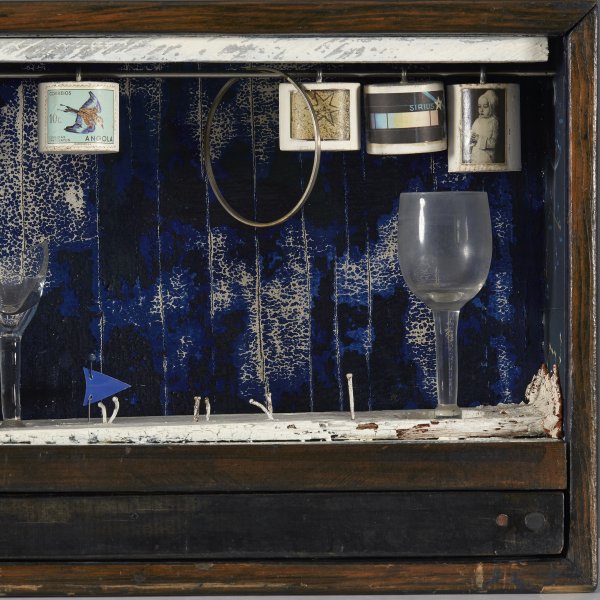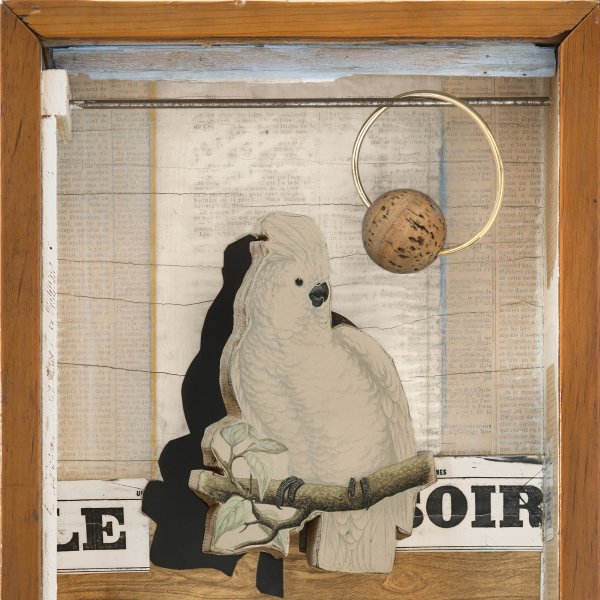Joseph Cornell
Nyack, 1903-Flushing, 1972
Joseph Cornell was linked to Surrealism in the United States. He created a whole universe of personal symbols in his characteristic boxes, in which he placed objects and prints.
Cornell began to develop an interest in art in the 1920s, while working as a textile salesman. During this period he visited numerous exhibitions of contemporary art, and in 1931 he visited Julien Levy’s newly opened gallery that was then showing a series of collages made by Max Ernst. Soon afterwards Cornell showed his own collages to Levy, who brought him into contact with many Surrealist artists, notably Marcel Duchamp. In 1932 his works were included in the first exhibition of Surrealist art organised by Levy’s gallery and his first one-man show was held there in November that year. He initially reused ready-made boxes but from 1932 to 1935 he learned woodwork from a neighbour and from then onwards nearly always made his own. In 1936 one of the latter was included in the Fantastic Art, Dada, Surrealism exhibition organised by Alfred H. Barr at The Museum of Modern Art in New York.
Nonetheless, Cornell did not fully identify with all the principles of the French movement, as he was uninterested in the subconscious or in erotic themes. About 1936 Cornell produced Rose Hobart, a collage-film for which he reused scenes from East of Borneo (1931) in which Rose Hobart had starred.
Later, in the 1950s, he was involved in producing other films with Rudy Burckhardt and Stan Brakhage. After ceasing to work as a textile designer — an activity in which he was engaged from 1934 to 1940 — he concentrated more on writing and published many articles for View and Dance Index. The death of his brother and mother, with whom he had lived until then, and the deterioration of his own health led him to devote considerably less time to art during the final years.
Cornell began to develop an interest in art in the 1920s, while working as a textile salesman. During this period he visited numerous exhibitions of contemporary art, and in 1931 he visited Julien Levy’s newly opened gallery that was then showing a series of collages made by Max Ernst. Soon afterwards Cornell showed his own collages to Levy, who brought him into contact with many Surrealist artists, notably Marcel Duchamp. In 1932 his works were included in the first exhibition of Surrealist art organised by Levy’s gallery and his first one-man show was held there in November that year. He initially reused ready-made boxes but from 1932 to 1935 he learned woodwork from a neighbour and from then onwards nearly always made his own. In 1936 one of the latter was included in the Fantastic Art, Dada, Surrealism exhibition organised by Alfred H. Barr at The Museum of Modern Art in New York.
Nonetheless, Cornell did not fully identify with all the principles of the French movement, as he was uninterested in the subconscious or in erotic themes. About 1936 Cornell produced Rose Hobart, a collage-film for which he reused scenes from East of Borneo (1931) in which Rose Hobart had starred.
Later, in the 1950s, he was involved in producing other films with Rudy Burckhardt and Stan Brakhage. After ceasing to work as a textile designer — an activity in which he was engaged from 1934 to 1940 — he concentrated more on writing and published many articles for View and Dance Index. The death of his brother and mother, with whom he had lived until then, and the deterioration of his own health led him to devote considerably less time to art during the final years.






